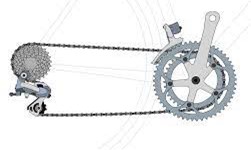Riding My Bike Teaches Me Lean Lessons

This week I will reach the milestone of 500 miles riding my bike back and forth to Dunkin Donuts at 10 miles per round trip. It takes me about 27 minutes each way and I take a 10-minute break for DD iced coffee and munchkins. These rides give me plenty of time to reflect on how riding my bike offers some interesting lean lessons.
My bike has thin tires, three sprockets up front and seven sprockets in the rear. I have a couple of small bags for carrying small items with me. Finally, is a $60 instrument cluster: odometer for miles per trip and accumulated miles driven, speedometer and clock. This is how I measure performance.
So how does this all relate to lean? The three front sprockets of varying diameters represent the current mental state of my clients.
- The small sprocket represents an organization that uses little effort but progresses very slowly.
- The middle sprocket represents the majority of organizations that pay a little attention to making improvements but lack the commitment and tools to make good progress.
- Of course, the large sprocket represents the organizations that are serious about committing to significant improvements but may lack training and leadership to achieve their potential.
Keep in mind that the goal is to find the combination of sprockets that drives us the furthest toward delivering the highest quality in the shortest lead time at the lowest cost.

Now the seven rear sprockets – what do they do? These seven sprockets range from small to large in diameter. On their own, they represent the different lean tools we can use to eliminate waste and non-value-added work to get closer to achieving our goal. Which rear sprocket or tool I use depends on whether I am going uphill, straight & level or downhill. Using the smallest diameter rear sprocket is the most difficult as it takes the most effort and encounters the most resistance. It turns out that this significant effort gives the most forward speed. You get what you pay for.
Ok, so we know that the three front sprockets are connected to the rear sprockets with a chain. So what? Well, this “chain” is how we look at the improvement mindset of the organization and link that to the lean tools (that they might be using or might want to use). If your organization is not willing to invest in lean thinking, metaphorically, the front large sprocket is being used (least effort to drive the chain or smallest leverage) along with the smallest rear sprocket to apply the least amount of effort and correspondingly lowest speed or progress towards the goal.
On the other hand, if your organization is metaphorically using the small, front sprocket trying to get the most leverage, you will want to go through each of the rear sprockets to see which of those lean tools best applies to your immediate goal or situation. The smallest rear sprocket is best for overcoming the resistance of going uphill but takes more effort. On the straight aways you have resources available to deploy in your improvement efforts; you may want to use a middle rear sprocket. The analogy is that we have many effective lean tools available to apply depending on your motivation and commitment to overcome resistance to change.
Don’t forget the “derailers.” These are the mechanisms that let you change gears to higher motivation and the correct selection of sprockets/ tools. Without a lean expert to help guide your progress, you won’t be able to achieve your improvement goal. Another more different and sinister explanation of the word “derailer” is all those “workflow interrupters” that get in the way. Lean experts have tools that eliminate those workflow interrupters. In our story here, the lean expert knows how to develop the plan, manage the derailers and optimize the gear/ sprocket selection.
Fundamental to all this thinking is using the instrument cluster on the front of the bike. It is constantly informing you of your tracking metrics, such as miles traveled, speed and time. We need to be constantly monitoring key metrics in short intervals to allow for intervention. Next week is too late to impact your performance today.
You may know the lean tools as elimination of the 7 Wastes, Standard Work, Visual Management, Workload Balancing, Mistake Proofing, Root Cause Analysis, Quick Changeover, Kanban, etc. So, to achieve the goal of delivering the highest quality in the shortest lead time at the lowest cost, you need to motivate the organization to have the right mindset and then learn to apply the appropriate lean tools for the improvements you want to achieve.
This post was authored by: Stephen Wilkinson, MBA
Rapid Lean Coach
RapidLeanCoach.com
Reach out to Steve:
RapidLeanCoach@gmail.com